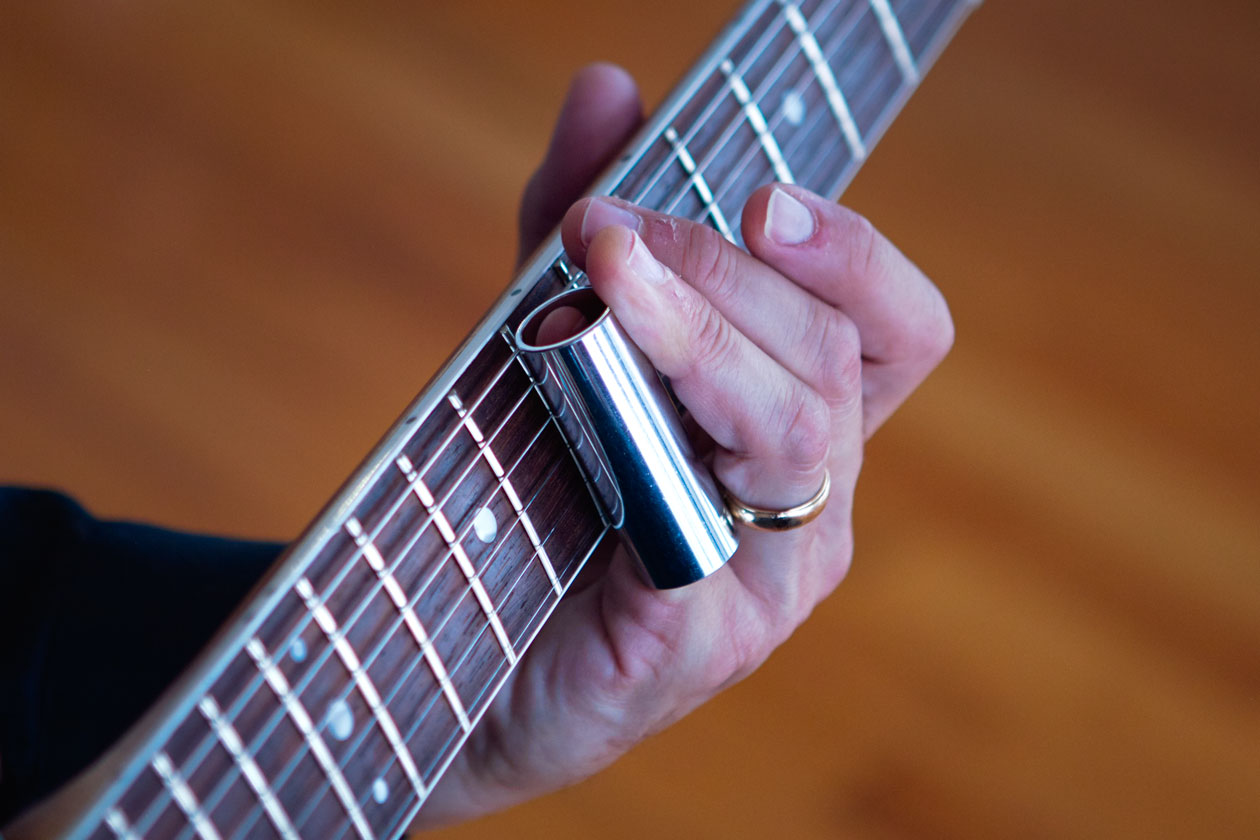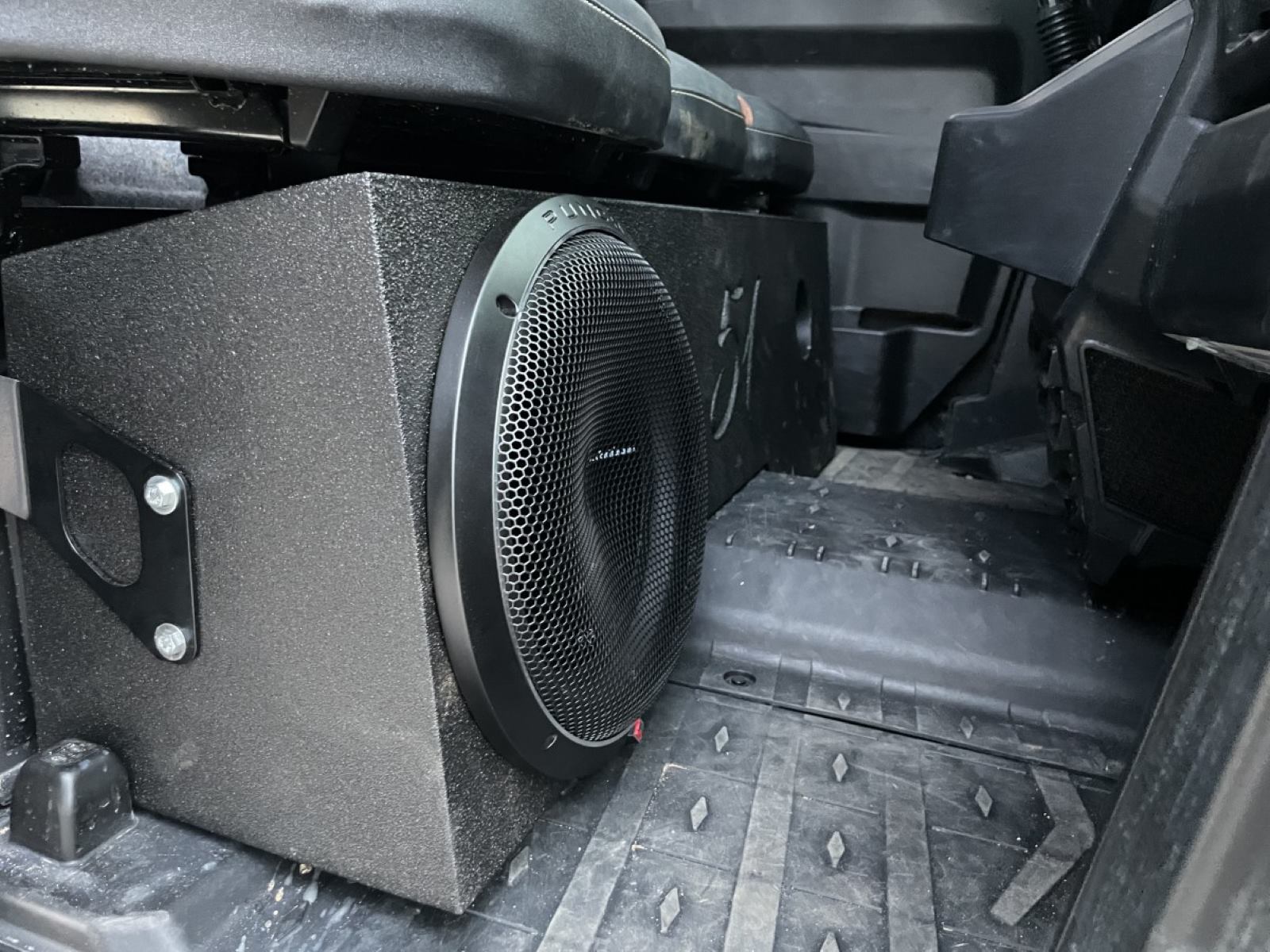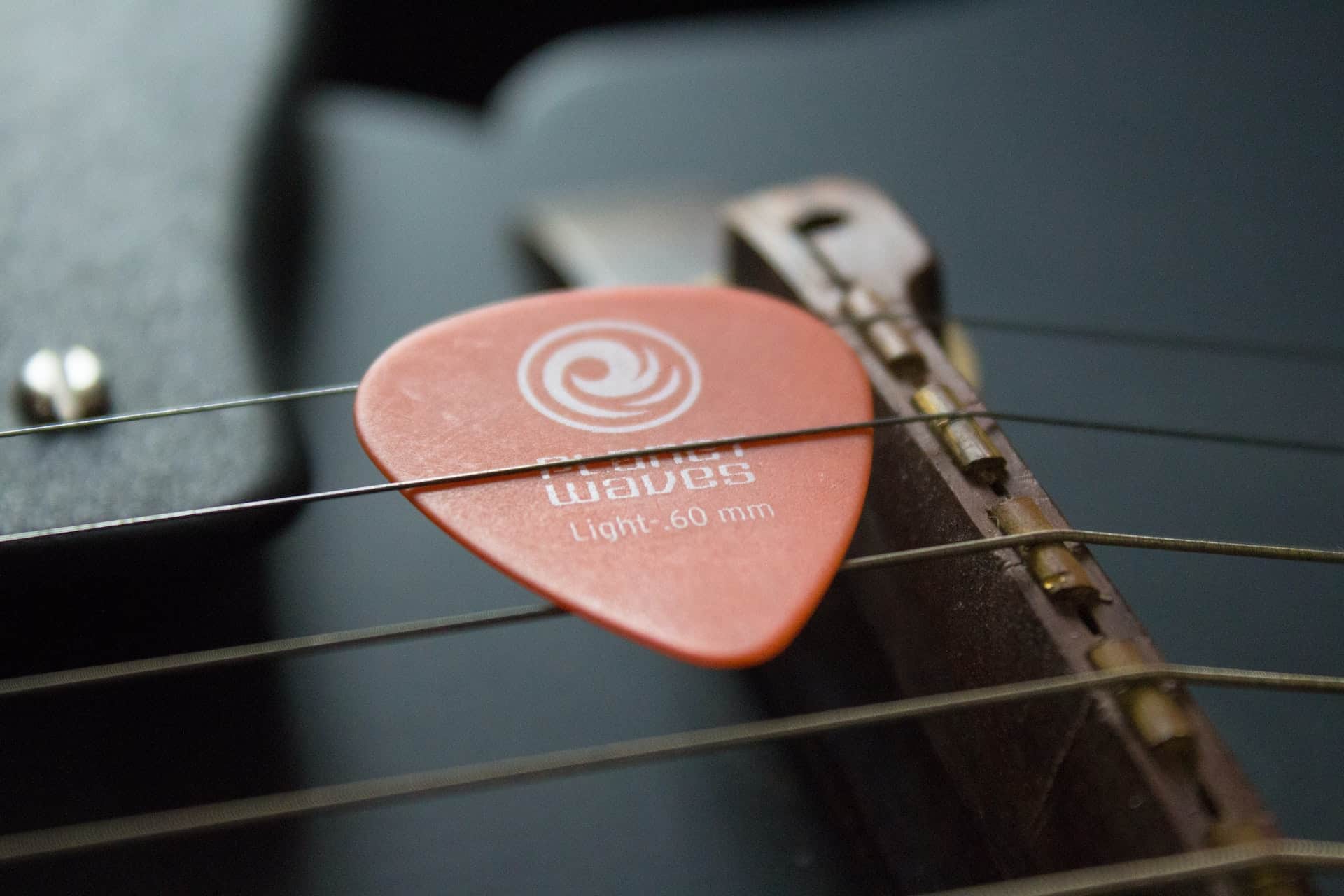Home>Instruments>Guitar>How To Use A Slide On Guitar


Guitar
How To Use A Slide On Guitar
Published: February 14, 2024
Learn how to use a slide on guitar to create smooth, expressive sounds. Master essential techniques and elevate your guitar playing skills today.
(Many of the links in this article redirect to a specific reviewed product. Your purchase of these products through affiliate links helps to generate commission for AudioLover.com, at no extra cost. Learn more)
Table of Contents
Introduction
Welcome to the world of slide guitar playing! Whether you're a seasoned guitarist looking to expand your repertoire or a beginner eager to explore new techniques, using a slide on your guitar can add a whole new dimension to your playing style. The distinctive sound of a slide, also known as a bottleneck, can evoke emotions ranging from soulful and bluesy to haunting and ethereal. In this comprehensive guide, we'll delve into the art of using a slide on guitar, covering everything from the basics to advanced techniques.
Using a slide involves sliding a smooth, hard object, such as a glass, metal, or ceramic cylinder, across the strings of the guitar to produce fluid, gliding notes. This technique is deeply rooted in blues and country music but has found its way into various genres, making it a versatile skill for any guitarist to master.
Throughout this article, we'll explore the fundamentals of slide guitar playing, including selecting the right slide, preparing your guitar for slide playing, and mastering basic and advanced techniques. Additionally, we'll provide valuable tips to help you improve your slide guitar playing and elevate your musical expression.
So, grab your guitar, choose your slide, and get ready to embark on a journey that will expand your musical horizons and unleash your creativity. Whether you're drawn to the soulful wails of blues slide guitar or the twangy resonance of country slide, this guide will equip you with the knowledge and techniques to infuse your playing with the distinctive and evocative sounds of the slide guitar.
Understanding the Basics of Slide Guitar
Before diving into the world of slide guitar playing, it’s essential to grasp the foundational concepts that underpin this unique technique. At its core, slide guitar playing involves using a slide, typically a cylindrical object made of glass, metal, or ceramic, to glide across the strings of the guitar. This creates a smooth and continuous transition between notes, producing a distinctively fluid and emotive sound.
One of the defining characteristics of slide guitar is the ability to achieve microtonal variations in pitch, allowing for the expression of subtle nuances and inflections that are challenging to replicate with conventional fretting techniques. This capability lends slide guitar playing its soulful and evocative qualities, making it a favored technique for conveying raw emotion and musical storytelling.
Slide guitar playing is deeply rooted in blues music, with its origins tracing back to the early 20th century when blues musicians repurposed everyday objects, such as glass bottle necks, as makeshift slides. Over time, dedicated slide guitarists developed and refined the technique, expanding its influence across diverse musical genres, including rock, country, and folk.
Understanding the basics of slide guitar also entails familiarizing yourself with open tunings, which are commonly used to complement the slide technique. Open tunings involve tuning the guitar’s strings to form a chord when strummed open, providing a harmonious foundation for slide playing. Open tunings, such as open D (D-A-D-F#-A-D) and open G (D-G-D-G-B-D), are popular choices among slide guitarists due to their resonance and compatibility with slide techniques.
By comprehending the fundamental principles of slide guitar playing, including the role of the slide, the expressive potential of microtonal variations, and the synergy with open tunings, you’ll establish a solid foundation for honing your slide guitar skills. With this knowledge in hand, you’re poised to explore the nuances of slide guitar playing and embark on a captivating musical journey that transcends traditional fretted techniques.
Choosing the Right Slide
When venturing into the realm of slide guitar playing, selecting the right slide is a crucial decision that significantly impacts your playing experience and the tonal characteristics of your guitar. Slides come in various materials, each offering distinct sonic qualities and tactile sensations, thereby influencing the overall sound and feel of your playing.
One of the most popular materials for slides is glass, renowned for its smoothness and bright, singing tones. Glass slides produce a clear and articulate sound, making them ideal for achieving crystalline sustain and expressive clarity. Additionally, the smooth surface of glass slides facilitates seamless gliding across the strings, enabling precise control over note transitions and articulations.
Metal slides, crafted from materials such as brass, steel, or chrome, offer a contrasting tonal palette characterized by rich harmonics and pronounced sustain. Metal slides impart a bold and assertive voice to the guitar, delivering robust overtones and a distinctive bite that resonates with power and authority. The weight and density of metal slides contribute to their commanding presence and the ability to coax vibrant, resonant tones from the instrument.
For guitarists seeking a balance between the brightness of glass and the weight of metal, ceramic slides present an appealing alternative. Ceramic slides exhibit a warm and rounded tonality, blending elements of glass’s clarity with the heft of metal, resulting in a versatile and expressive sound. The inherent density of ceramic imparts a sense of solidity and depth to the notes, making it a favored choice for players seeking a nuanced and responsive slide experience.
Aside from material considerations, the dimensions of the slide also play a pivotal role in shaping your playing dynamics. Longer slides provide a broader range for string coverage, allowing for extended note sustain and facilitating wide intervallic movements. Conversely, shorter slides offer enhanced maneuverability and precise control, making them well-suited for intricate phrasing and rapid slide techniques.
By carefully considering the sonic characteristics, tactile qualities, and dimensions of different slides, you can tailor your selection to align with your playing style and sonic preferences. Whether you’re drawn to the shimmering clarity of glass, the commanding presence of metal, or the balanced versatility of ceramic, choosing the right slide empowers you to unlock the full expressive potential of slide guitar playing and imbue your music with captivating resonance and emotive depth.
Preparing Your Guitar for Slide Playing
Before delving into the expressive realm of slide guitar playing, it’s essential to prepare your instrument to optimize its responsiveness and sonic characteristics for slide techniques. This involves making thoughtful adjustments to the guitar’s setup, including addressing string action, string gauge, and intonation, to ensure a seamless and rewarding slide playing experience.
String action, referring to the height of the strings above the fretboard, significantly influences the playability and tonal output when using a slide. To facilitate smooth and effortless sliding, it’s beneficial to set the string action slightly higher than the standard setup for fretted playing. Elevating the string action minimizes the likelihood of the slide inadvertently contacting the frets, preventing unwanted buzzing and ensuring clear, sustained notes during slide maneuvers.
Choosing the appropriate string gauge is another pivotal consideration when preparing your guitar for slide playing. Heavier gauge strings, such as medium or heavy sets, offer enhanced resistance to fret buzz and facilitate robust tonal projection when combined with slide techniques. The increased tension and mass of heavier strings contribute to improved sustain and stability, allowing for confident and expressive slide articulations.
Intonation adjustment is crucial for achieving accurate pitch reproduction across the fretboard, particularly when employing open tunings in conjunction with slide techniques. Fine-tuning the intonation ensures that the guitar produces harmonically precise notes when played with a slide, enabling seamless transitions between different fret positions and facilitating melodic expression across the entire span of the instrument.
Furthermore, considering the material and profile of the guitar’s nut and saddle can enhance the performance and tonal integrity during slide playing. Utilizing materials such as bone or graphite for the nut and saddle can contribute to improved sustain, resonance, and string stability, complementing the nuances of slide techniques and enriching the overall sonic character of the instrument.
Applying a meticulous approach to preparing your guitar for slide playing not only optimizes its responsiveness and tonal qualities but also fosters a symbiotic relationship between the instrument and the slide, enabling seamless integration of expressive techniques and emotive phrasing. By fine-tuning the setup to accommodate the unique demands of slide playing, you can unlock the full sonic potential of your guitar and embark on a captivating musical journey infused with the evocative sounds of the slide.
Basic Techniques for Using a Slide
Mastering the fundamental techniques for using a slide is essential for harnessing the expressive potential of this unique playing style. Whether you’re aiming to evoke soulful blues laments, add a touch of twang to country melodies, or infuse rock solos with emotive slides, understanding and practicing basic slide techniques is the gateway to unlocking a world of evocative musical expression.
One of the foundational techniques in slide guitar playing is the art of slide positioning. When using a slide, it’s crucial to maintain consistent and even pressure against the strings, ensuring that the slide makes full contact with the fretboard to produce clear and sustained notes. Experimenting with different finger placements and angles can help you discover the optimal position for achieving smooth and articulate slide movements.
Another fundamental aspect of slide technique is intonation control. As you glide the slide across the strings, pay close attention to the placement of the slide relative to the frets to achieve accurate pitch reproduction. Practicing precise intonation control enables you to navigate between notes with clarity and finesse, allowing for seamless melodic phrasing and expressive slides.
Furthermore, developing a nuanced approach to slide articulation is essential for imbuing your playing with dynamic expression. By varying the pressure and speed of the slide movements, you can evoke a range of tonal nuances, from gentle, ethereal glides to assertive, resonant slides. Experimenting with different articulation techniques empowers you to convey a spectrum of emotions and musical textures through your slide playing.
Exploring vibrato techniques with the slide adds a layer of emotive depth to your playing, enabling you to infuse sustained notes with subtle shimmers and expressive fluctuations in pitch. By incorporating controlled vibrato into your slide passages, you can imbue your melodies with a captivating sense of fluidity and emotional resonance, elevating the evocative impact of your performances.
As you acquaint yourself with these basic slide techniques, dedicating focused practice and attentive listening will facilitate your mastery of the slide’s expressive potential. Embracing the nuances of slide positioning, intonation control, articulation, and vibrato empowers you to craft stirring musical narratives and imbue your playing with the soulful, emotive character that defines the art of slide guitar.
Advanced Slide Guitar Techniques
Delving into the realm of advanced slide guitar techniques unveils a rich tapestry of expressive possibilities, allowing players to push the boundaries of sonic exploration and musical storytelling. As you progress in your slide guitar journey, incorporating advanced techniques into your playing repertoire can elevate your musical expression and unlock a wealth of evocative textures and tonal nuances.
One advanced technique that adds depth and complexity to slide guitar playing is harmonics manipulation. By selectively applying the slide to specific nodal points on the strings, you can coax out ethereal and bell-like harmonics, creating a mesmerizing sonic landscape that transcends conventional fretted playing. Experimenting with harmonics using the slide opens up a world of shimmering overtones and celestial textures, enriching your musical palette with otherworldly resonance.
Exploring polyphonic techniques with the slide enables you to craft intricate and harmonically rich passages that intertwine multiple voices within a single phrase. By selectively engaging strings with the slide while employing fingerpicking or plucking techniques, you can create captivating melodic interplay and contrapuntal textures, infusing your compositions with a sense of depth and complexity that captivates the listener’s ear.
Utilizing microtonal inflections with the slide allows for the expression of subtle tonal nuances and emotive phrasing that transcend the constraints of traditional fretted intonation. By skillfully manipulating the slide to introduce microtonal bends and glides, you can imbue your playing with a sense of fluidity and emotive depth, evoking a spectrum of nuanced emotions and musical colors that resonate with profound expressive impact.
Furthermore, integrating percussive elements into your slide playing repertoire can enhance the rhythmic dynamism and textural diversity of your performances. By incorporating percussive strikes, taps, and slaps in conjunction with slide techniques, you can infuse your playing with rhythmic vitality and tactile resonance, adding an engaging layer of rhythmic complexity to your slide guitar compositions.
Embracing these advanced slide guitar techniques empowers you to transcend conventional boundaries and embark on a boundless sonic journey, where expressive possibilities abound and musical narratives unfold with captivating depth and emotional resonance. By nurturing your proficiency in harmonics manipulation, polyphonic exploration, microtonal inflections, and percussive integration, you can unlock a world of sonic expression that amplifies the evocative power of the slide guitar and elevates your playing to new heights of artistic exploration.
Tips for Improving Your Slide Guitar Playing
Enhancing your proficiency in slide guitar playing involves a combination of focused practice, attentive listening, and a nuanced approach to technique. Whether you’re a novice seeking to refine your foundational skills or an experienced guitarist aiming to elevate your slide playing to new heights, integrating the following tips into your practice regimen can contribute to substantial strides in your slide guitar journey.
First and foremost, developing a keen ear for pitch and intonation is paramount in honing your slide guitar skills. Practicing scales, melodies, and intervals with the slide allows you to cultivate a heightened sense of pitch accuracy and tonal control, enabling you to navigate the fretboard with precision and finesse. Additionally, actively listening to accomplished slide guitarists and studying their phrasing and intonation can provide valuable insights into nuanced slide techniques and expressive nuances.
Experimenting with various slide materials and dimensions can offer valuable insights into the sonic characteristics and tactile nuances of different slides. By exploring glass, metal, and ceramic slides of different lengths and diameters, you can discover the tonal qualities and playing dynamics that resonate with your musical sensibilities, ultimately informing your choice of slide and enhancing your expressive capabilities.
Embracing open tunings, such as open D and open G, can enrich your slide guitar repertoire by providing a harmonically rich and resonant foundation for slide playing. Familiarizing yourself with the unique chord voicings and intervallic relationships within open tunings empowers you to craft compelling slide compositions and explore a diverse range of melodic possibilities that transcend traditional fretted playing.
Developing a nuanced approach to dynamics and expression is essential for imbuing your slide playing with emotive depth and musical storytelling. By mastering the art of dynamic control, from delicate whispers to soaring crescendos, you can infuse your slide passages with a sense of narrative arc and emotional resonance, captivating listeners with the evocative power of your playing.
Lastly, embracing a mindset of continual exploration and experimentation fosters artistic growth and innovation in your slide guitar journey. Embracing a spirit of curiosity and fearlessness in exploring new techniques, sonic textures, and musical genres empowers you to expand the horizons of your slide playing, fostering a dynamic and evolving musical identity that reflects your expressive depth and artistic vision.
By integrating these tips into your practice routine and creative explorations, you can embark on a transformative journey of growth and refinement in your slide guitar playing. Cultivating a keen ear for pitch, experimenting with slide materials and open tunings, mastering dynamic expression, and embracing a spirit of exploration collectively contribute to elevating your slide guitar proficiency and nurturing a deeply resonant and expressive musical voice.
Conclusion
Embarking on the journey of slide guitar playing unveils a world of evocative sounds, expressive possibilities, and artistic exploration. From the soulful wails of blues slide to the twangy resonance of country slide, the slide guitar offers a captivating avenue for musicians to infuse their playing with emotive depth and sonic richness. Throughout this comprehensive guide, we’ve explored the foundational principles, techniques, and considerations that underpin the art of using a slide on guitar, equipping you with the knowledge and insights to embark on a fulfilling and expressive slide guitar journey.
Understanding the basics of slide guitar, from the role of the slide to the expressive potential of microtonal variations and open tunings, forms the bedrock of your journey into slide playing. Selecting the right slide, whether it be glass, metal, or ceramic, and preparing your guitar for slide techniques empowers you to optimize your instrument’s responsiveness and tonal qualities, setting the stage for compelling and emotive slide performances.
Mastering basic techniques, such as slide positioning, intonation control, articulation, and vibrato, lays the groundwork for infusing your playing with dynamic expression and emotive depth. As you progress, delving into advanced techniques, including harmonics manipulation, polyphonic exploration, microtonal inflections, and percussive integration, opens up a world of sonic exploration and musical storytelling that transcends conventional boundaries.
By embracing a spirit of continual growth and refinement, integrating tips for improving your slide guitar playing, and nurturing a nuanced approach to technique and expression, you can cultivate a deeply resonant and expressive musical voice that captivates and inspires. Whether you’re drawn to the haunting laments of blues slide, the vibrant textures of rock slide, or the melodic richness of country slide, the slide guitar offers a boundless canvas for artistic expression and sonic innovation.
As you embark on your slide guitar journey, remember that mastery is a product of dedication, curiosity, and a willingness to explore new horizons. Embrace the evocative power of the slide, cultivate your expressive voice, and let the resonant tones and emotive textures of the slide guitar become a compelling extension of your musical identity. With each slide and glissando, may your playing resonate with soul-stirring depth and storytelling prowess, enriching the musical tapestry with the timeless allure of the slide guitar.











